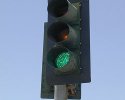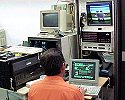Primary FunctionsThe primary functions of traffic signals include assigning right of way to various traffic movements at intersections and permitting pedestrians, bicyclists and cross-street traffic to move safely through the intersection and reduce certain types of accidents, particularly severe right angle (broadside) collisions.
Traffic Signal Maintenance
Traffic signal maintenance is a high priority for SACDOT. Traffic signal crews are in the field Monday to Friday to monitor and service our traffic signal system. Department staff also provides coverage 24/7, 365 days per year for emergency response to signal malfunctions, storm or vehicle damage, etc. SACDOT’s goal is a response to traffic signal service requests with-in one hour of notification.
Typical problems/requests that warrant an immediate response from signal maintenance crews include:
- All lights out due to power outage.
- Signals flashing red in all directions.
- Loose or turned signal heads.
- Damage caused by vehicles.
- Burned out lamps.
- Timing Problems – long red or short green.
The public is encouraged to report any problems that require immediate attention in order to ensure safety for all types of transportation on our roadways.
See the contact information below to report a signal problem.
Two Types of Signals
 The County has two types of traffic signals: actuated signals and semi-actuated signals. An actuated signal places detectors on all legs of the intersection and changes the timing of the lights to maximize traffic flow. A semi-actuated signal utilizes detectors only on the minor cross street. When the detector is activated, the green light on the major street is interrupted to allow the minor street traffic to safely enter the intersection.
The County has two types of traffic signals: actuated signals and semi-actuated signals. An actuated signal places detectors on all legs of the intersection and changes the timing of the lights to maximize traffic flow. A semi-actuated signal utilizes detectors only on the minor cross street. When the detector is activated, the green light on the major street is interrupted to allow the minor street traffic to safely enter the intersection.
FYI... If heavy traffic congestion causes you to stop and block traffic in the middle of the intersection, you can be cited. Before entering the intersection, you should check to see if there is enough space to completely cross before the light turns red.
What Process Determines Which Intersections are Signalized?
 Those locations which meet the requirements are ranked according to relative severity and placed on a priority list. County engineers then review the list and recommend which locations should be considered for funding and construction.
Those locations which meet the requirements are ranked according to relative severity and placed on a priority list. County engineers then review the list and recommend which locations should be considered for funding and construction.
Traffic Signal Timing
SACDOT is responsible for the timing of traffic signals on unincorporated area roadways. At each signalized intersection, the signal indications (i.e., green, yellow, red) are programmed based on traffic demands from all directions. Traffic signals on major corridors are synchronized to provide optimal and efficient traffic flow. For more information on traffic timing, please visit the Traffic Operations page.
Contact Information
To report a timing problem or malfunctioning traffic signal or to request that a new traffic signal be built in your neighborhood, please:
Call 311 or 875-4311 or report online at www.311.saccounty.net
